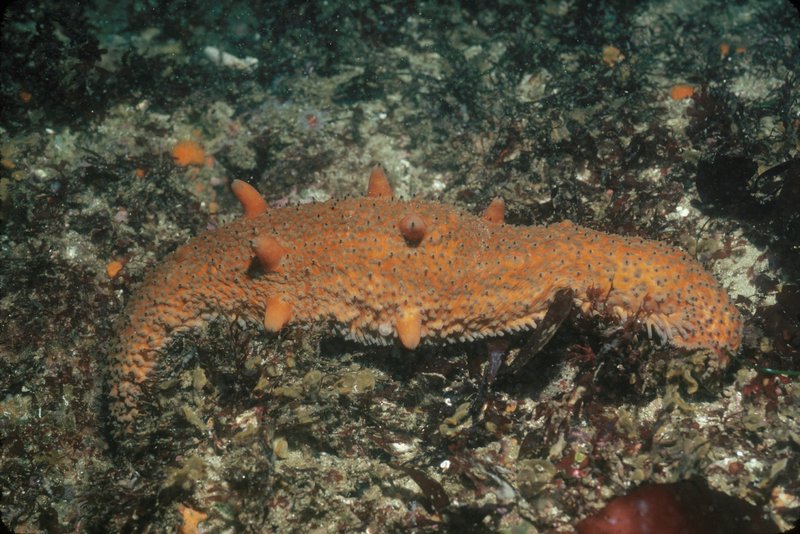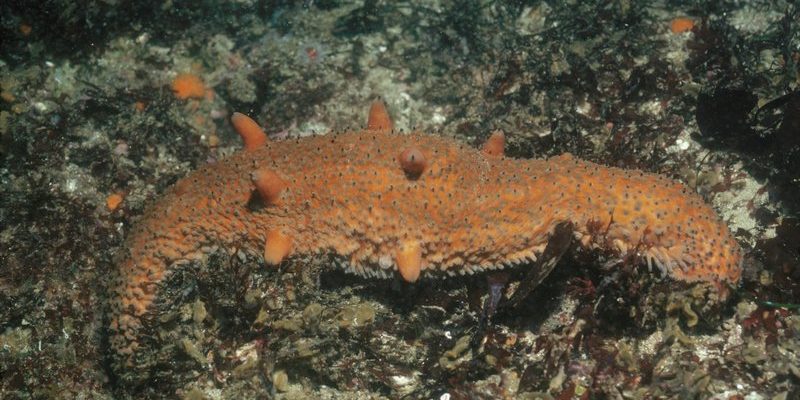
Imagine strolling along a sun-drenched beach, the gentle waves lapping at your feet. You might not think much about what lies beneath the surface, but the ocean is home to some peculiar creatures, one of which is the warty sea cucumber. This marine animal may not be as glamorous as a dolphin or as colorful as a tropical fish, but it plays a vital role in its underwater ecosystem.
The warty sea cucumber, often found in shallow waters, is a fascinating creature with a soft, elongated body covered in warty, bumpy skin. This unique texture isn’t just for show. It’s an adaptation that helps the sea cucumber blend into its environment, protecting it from predators while aiding in its survival. But there’s more to these fascinating beings than just their looks—let’s dive deeper into their world.
What is a Warty Sea Cucumber?
The warty sea cucumber is a type of echinoderm, which means it’s related to starfish and sea urchins. They are primarily found in tropical and subtropical waters around the world. These creatures can reach lengths of up to 12 inches or more, and their bodies come in various colors, typically ranging from brown to green, camouflaging with the seafloor and coral reefs.
One of the most remarkable features of the warty sea cucumber is its ability to regenerate. If threatened, they can expel part of their internal organs as a defense mechanism, which can then grow back later. Isn’t it incredible to think about such resilience? Here’s the thing: that’s just one of the many ways they adapt to their environment and survive in the wild.
Habitat and Distribution
Warty sea cucumbers primarily inhabit shallow waters, often found in sandy or muddy seafloors. They love regions where there are plenty of organic materials to feed on—places where detritus, or decaying plant and animal matter, gathers. You can typically find these creatures in areas of the Atlantic and Indian Oceans, especially around coral reefs and lagoons.
Their ability to thrive in varying conditions makes them quite intriguing. Some might be found in deeper waters, while others prefer more sheltered spots. This versatility allows them to adapt to changes in their environment, such as fluctuations in temperature and salinity, which can be pretty common in marine habitats.
Diet and Feeding Habits
The warty sea cucumber is a detritivore, meaning it primarily feeds on decomposing organic material. They have a unique feeding mechanism that involves extending their tentacles to gather food particles from the seafloor. This process is similar to how you might sift through sand at the beach, searching for little treasures.
As they eat, they play a crucial role in the ecosystem. By processing organic material and recycling nutrients back into the ocean, they help maintain the health of the marine environment. It’s like they’re nature’s clean-up crew! And while they may not have the flashiest diet, their contribution to the underwater world is significant.
Physical Characteristics
One look at a warty sea cucumber, and you’ll see why they’re so aptly named. Their bodies are covered in distinct warty growths, which give them a bumpy appearance. These warts are not just for looks; they serve as a protective measure. Some species might even have a sticky or slimy texture to deter potential predators. It’s like wearing a suit of armor!
Additionally, their bodies are soft and flexible, allowing them to squeeze into tight spaces in the ocean floor. This helps them evade predators and find a comfortable resting spot. The color of their skin also plays a critical role in their survival, as the brown and green hues blend seamlessly with their surroundings, making them less visible to would-be attackers.
Reproduction and Lifespan
Warty sea cucumbers reproduce through a process called external fertilization. During mating, males will release sperm into the water, while females release eggs, resulting in a fertilization process that takes place outside the body. It’s quite fascinating to think about how their young begin life floating around in the ocean currents!
The lifespan of a warty sea cucumber can vary, with some living for several years, while others may only survive a short time due to environmental stress or predation. They have natural predators, including fish and crabs, which can impact their population. However, their ability to regenerate adds a layer of resilience to their life cycle.
Ecological Importance
The ecological role of the warty sea cucumber extends beyond just eating decomposing matter. By feeding on detritus, they help recycle nutrients within their habitat, contributing to the overall health of the marine ecosystem. Think of them as tiny gardeners of the ocean floor, tirelessly working to keep their environment in balance.
Moreover, their burrowing behavior aerates the sand and sediment, promoting healthier habitats for other marine life. This process helps maintain the delicate equilibrium that so many organisms rely on. If you’re ever at the beach, take a moment to appreciate these hidden workers of the ocean!
Threats and Conservation
Unfortunately, warty sea cucumbers face various threats, many of which stem from human activity. Overfishing is a significant concern, as these creatures are harvested for food in some regions. Additionally, habitat destruction due to coastal development and pollution can also impact their populations.
Conservation efforts are essential for the survival of the warty sea cucumber. Protecting their habitats and regulating fishing practices are crucial steps in ensuring these fascinating creatures thrive in the wild. By raising awareness about their ecological importance, we can help safeguard their future and maintain the health of our oceans.
Interesting Facts
| Scientific Name: | Holothuria grisea |
| Size: | Up to 12 inches |
| Color: | Brown, green |
| Diet: | Detritivore |
| Habitat: | Shallow waters, sandy/muddy floors |
| Lifespan: | Several years |
FAQ
What is the warty sea cucumber’s main habitat?
The warty sea cucumber primarily resides in shallow ocean waters, often found on sandy or muddy seabeds. These areas provide ample organic material for feeding, making them ideal habitats for these creatures. You’ll typically find them in tropical and subtropical regions, particularly around coral reefs and lagoons.
How do warty sea cucumbers defend themselves?
Warty sea cucumbers have several defense mechanisms. One of the most fascinating is their ability to expel part of their internal organs when threatened, allowing them to escape predators. These expelled organs can regenerate over time, making this adaptation quite remarkable. Additionally, their bumpy skin and color help them blend into their surroundings, acting as a camouflage against predators.
Are warty sea cucumbers endangered?
While not currently listed as endangered, warty sea cucumbers face threats from overfishing and habitat destruction. Certain regions have seen declines in their populations due to the harvesting of these creatures for food. Conservation efforts are crucial to preserving their habitats and regulating fishing practices to ensure their survival.
What do warty sea cucumbers eat?
Warty sea cucumbers are detritivores, primarily feeding on decomposing organic matter found on the seafloor. They extend their tentacles to capture food particles, recycling nutrients back into the ecosystem. This nutritious material is essential for the health of their environment, showcasing their role in maintaining marine ecosystems.
How do warty sea cucumbers reproduce?
Warty sea cucumbers reproduce through external fertilization. Males release sperm into the water while females release eggs, leading to fertilization outside their bodies. The larvae released into the ocean currents eventually settle on the seafloor, where they grow into adult sea cucumbers. This process highlights their fascinating life cycle!
Can warty sea cucumbers regenerate if injured?
Yes, warty sea cucumbers have an impressive ability to regenerate. If they are injured or threatened, they can expel part of their internal organs, which can later grow back. This regenerative ability is vital for their survival, enabling them to recover from various threats in their environment.
How long do warty sea cucumbers live?
The lifespan of a warty sea cucumber can vary, with some individuals living for several years. Factors such as environmental conditions and predation can affect their longevity. However, their adaptability and regenerative abilities play a vital role in their survival in the wild.
Are warty sea cucumbers harmful to humans?
No, warty sea cucumbers are not harmful to humans. They are harmless creatures that play an essential role in the marine ecosystem. In fact, in some cultures, they are considered a delicacy and are harvested for food. However, people should exercise caution when interacting with marine life to preserve their habitats.
What is the role of warty sea cucumbers in the ecosystem?
Warty sea cucumbers play a critical role in the ecosystem as detritivores. By consuming decomposing organic matter, they help recycle nutrients, which benefits other marine life. Additionally, their burrowing behavior aerates the sediment, promoting healthier habitats for various organisms. This ecological role is vital for maintaining marine health.
Where can I find warty sea cucumbers?
You can find warty sea cucumbers in tropical and subtropical regions, particularly in shallow waters that provide rich organic material for feeding. They are commonly seen around coral reefs and lagoons, making these areas great places to spot these fascinating beings.
Why are warty sea cucumbers important to marine ecosystems?
Warty sea cucumbers contribute to the overall health of marine ecosystems by recycling nutrients and promoting a balanced environment. Their feeding and burrowing behaviors aerate the seafloor and help maintain the delicate balance necessary for many marine organisms. Without creatures like the warty sea cucumber, the health of our oceans could be compromised.

